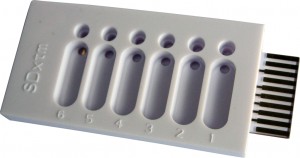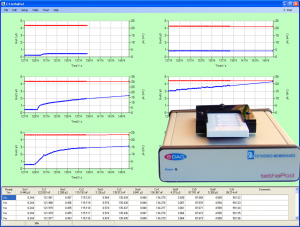Difference between revisions of "SDx Protocol 1"
(→Ionophore Addition) |
(→Solution Preparation) |
||
| Line 15: | Line 15: | ||
===Solution Preparation=== | ===Solution Preparation=== | ||
| − | Make a 1 mM stock solution of the ionophore in methanol. Suitable ionophores for teaching experiments are listed in the Application Note: [http://wiki.edaq.com/index.php/Ionophores_in_Society Ionophores in Society]. | + | Make a 1 mM stock solution of the ionophore in methanol. Suitable ionophores for teaching experiments are listed in the Application Note: [http://wiki.edaq.com/index.php/Ionophores_in_Society Ionophores in Society]. Long term storage of this stock solution at -20°C (ie in a freezer) is recommended. Overnight storage, or even for several days, can be done at 2-4°C (ie in a refrigerator). |
| − | Using the method of serial dilution prepare a series of solutions in decade concentration increments, allowing 200 uL per test well so that you have solutions of | + | |
| + | Using the method of serial dilution prepare a series of solutions in PBS buffer in decade concentration increments, allowing 200 uL per test well so that you have solutions of | ||
1, 10, 100, 1000, and 10000 nM. The 10000 nM solution will still contain only 1% methanol, which means that the solution is mainly water. Higher methanol concentrations can disrupt the membrane, or cause incomplete partitioning of the ionophore into the lipophilic membrane. | 1, 10, 100, 1000, and 10000 nM. The 10000 nM solution will still contain only 1% methanol, which means that the solution is mainly water. Higher methanol concentrations can disrupt the membrane, or cause incomplete partitioning of the ionophore into the lipophilic membrane. | ||
If you need to use more concentrated ionophore solutions then you will need to make a more concentrated stock solution (eg 10 or even 100 mM) and dilute this down to the desired levels. | If you need to use more concentrated ionophore solutions then you will need to make a more concentrated stock solution (eg 10 or even 100 mM) and dilute this down to the desired levels. | ||
| − | |||
[[File:tethaPod1.png|300px|thumb|right|'''Figure 2.''' A tethaPod unit, with its software in the background]] | [[File:tethaPod1.png|300px|thumb|right|'''Figure 2.''' A tethaPod unit, with its software in the background]] | ||
Revision as of 19:58, 8 August 2013
This protocol is suitable for the measurement of tethered membrane conductivity with most ionophores, and other low molecular weight (2000 Da or less) ion channels, using a tethaPod™ system.
Make sure you are familiar with the concept of tethered membranes and use of the tethaPod software.
The buffer solution used in this protocol is PBS (phosphate buffered saline) solution. However equivalent protocols using different buffer solutions can also be used, eg 0.1 M KCl, normal saline, various Good's buffers, TBS, etc.
Membrane formation
Assemble the tethaPlate as per its instructions. To each input well add 10 µL of SDx-S1 Phospholipid mix, and incubate for 2 minutes to allow the phospholipid bilayer membrane to form. Now add 200 µL PBS per well followed successively by three 200 µL PBS rinses. Remove the excess PBS from the waste well.
In cases where ion channel formation requires the presence of ergosterol or cholesterol (eg when studying Amphotericin B or Nystatin) it is necessary to add these substances the SDx-S1 Phospholipid Mix prior to membrane formation.
Solution Preparation
Make a 1 mM stock solution of the ionophore in methanol. Suitable ionophores for teaching experiments are listed in the Application Note: Ionophores in Society. Long term storage of this stock solution at -20°C (ie in a freezer) is recommended. Overnight storage, or even for several days, can be done at 2-4°C (ie in a refrigerator).
Using the method of serial dilution prepare a series of solutions in PBS buffer in decade concentration increments, allowing 200 uL per test well so that you have solutions of
1, 10, 100, 1000, and 10000 nM. The 10000 nM solution will still contain only 1% methanol, which means that the solution is mainly water. Higher methanol concentrations can disrupt the membrane, or cause incomplete partitioning of the ionophore into the lipophilic membrane.
If you need to use more concentrated ionophore solutions then you will need to make a more concentrated stock solution (eg 10 or even 100 mM) and dilute this down to the desired levels.
Ionophore Addition
Ensure all solutions are thermally equilibrated at room temperature before starting.
Start recording with the tethaPlate fitted to the tethaPod unit, proceed for several minutes until stable baseline signals are obtained for each of the sample wells. While still recording:
- Withdraw 200 µL of the PBS buffer from the tethaPlate waste well.
- Note the time and replace with 200 µL test solution at lowest ionophore concentration.
- Record the membrane conductivity for at least 5 minutes, or until the signal plateaus.
- Withdraw 200 µL of the old test solution from the tethaPlate waste well.
- Note the time and replace with 200 µL test solution at the next higher ionophore concentration.
- Record the membrane conductivity for at least 5 minutes, or until the signal plateaus.
- Repeat steps 4 to 6, until the highest ionophore concentration is reached (or until the conductivity signal goes off scale, or the membrane ruptures)
- Withdraw 200 µL of the old test solution from the tethaPlate waste well.
- Replace with 200 µL of the PBS buffer.
- Repeat steps 8 - 9 every minute, three times, and observe whether there is a decease in conductivity, indicating that the ionophore can be 'washed out'.
Presentation of Results
Prepare a graph of conductivity vs log of ionophore concentration.
It is usual to find that there is a sudden rise in conductivity over a single decade of concentration increase. If you want better resolution on your graph then repeat the experiment using a series of test solutions prepared over this smaller concentration range.

